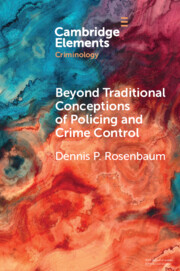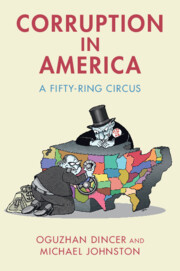Refine search
Actions for selected content:
242 results
State Absenteeism: Vigilantism and Security Provision in Latin America
-
- Journal:
- Latin American Politics and Society / Volume 67 / Issue 3 / August 2025
- Published online by Cambridge University Press:
- 27 August 2025, pp. 85-106
-
- Article
-
- You have access
- Open access
- HTML
- Export citation
Whose victimization pays? Policing innocent victimhood in victim compensation law
-
- Journal:
- Law & Society Review ,
- Published online by Cambridge University Press:
- 01 August 2025, pp. 1-37
-
- Article
-
- You have access
- Open access
- HTML
- Export citation
The Ethics of Defunding the Police
-
- Journal:
- Perspectives on Politics , First View
- Published online by Cambridge University Press:
- 25 July 2025, pp. 1-19
-
- Article
-
- You have access
- Open access
- HTML
- Export citation
Tracking (In)Justice: Documenting Fatal Encounters with Police in Canada
-
- Journal:
- Canadian Journal of Law & Society / La Revue Canadienne Droit et Société / Volume 40 / Issue 1 / April 2025
- Published online by Cambridge University Press:
- 16 June 2025, pp. 23-47
-
- Article
-
- You have access
- Open access
- HTML
- Export citation
2 - The Nazi Apparatus of Terror: SS, SA, Police
- from Part I - Structures, Players, and Processes
-
-
- Book:
- The Cambridge History of the Holocaust
- Published online:
- 21 May 2025
- Print publication:
- 12 June 2025, pp 51-71
-
- Chapter
- Export citation
20 - The Jewish Family during the Holocaust
-
-
- Book:
- The Cambridge History of the Holocaust
- Published online:
- 16 May 2025
- Print publication:
- 12 June 2025, pp 330-345
-
- Chapter
- Export citation

Beyond Traditional Conceptions of Policing and Crime Control
- New Metrics to Evaluate Police Performance and Improve Police Legitimacy
-
- Published online:
- 10 June 2025
- Print publication:
- 03 July 2025
-
- Element
- Export citation
23 - Moral Judgments about Retributive Vigilantism
- from Part III - Applications
-
-
- Book:
- The Cambridge Handbook of Experimental Jurisprudence
- Published online:
- 17 May 2025
- Print publication:
- 05 June 2025, pp 381-398
-
- Chapter
- Export citation
Creating the Modern Iranian Policeman: 1911–1935
-
- Journal:
- Iranian Studies ,
- Published online by Cambridge University Press:
- 05 June 2025, pp. 1-28
-
- Article
-
- You have access
- Open access
- HTML
- Export citation
The Rise of Modern Police Forces in the United Kingdom: Tracking Legislative Debates Around Police Reform (1803–1945)
-
- Journal:
- Social Science History / Volume 49 / Issue 2 / Summer 2025
- Published online by Cambridge University Press:
- 18 June 2025, pp. 395-421
- Print publication:
- Summer 2025
-
- Article
-
- You have access
- Open access
- HTML
- Export citation
13 - Criminal Justice Crisis
- from Part II - Self-Determination Meets Paternalism
-
- Book:
- Becoming Nations Again
- Published online:
- 17 April 2025
- Print publication:
- 24 April 2025, pp 190-209
-
- Chapter
-
- You have access
- Open access
- HTML
- Export citation
2 - The Definition of Other Ill-Treatment under International Law
-
- Book:
- The Prohibition of Torture and Ill-Treatment under International Law
- Published online:
- 17 April 2025
- Print publication:
- 24 April 2025, pp 46-74
-
- Chapter
- Export citation
8 - The Regulation of Extra-Custodial Use of Force by the Police
-
- Book:
- The Prohibition of Torture and Ill-Treatment under International Law
- Published online:
- 17 April 2025
- Print publication:
- 24 April 2025, pp 193-214
-
- Chapter
- Export citation
4 - Proving Prostitution
-
- Book:
- Immoral Traffic
- Published online:
- 06 March 2025
- Print publication:
- 24 April 2025, pp 94-127
-
- Chapter
- Export citation
3 - “These Girls Never Give Statements”
-
- Book:
- Immoral Traffic
- Published online:
- 06 March 2025
- Print publication:
- 24 April 2025, pp 70-93
-
- Chapter
- Export citation
6 - Law Enforcement and the Judiciary in Postrevolutionary Iran
-
-
- Book:
- The Rule of Law in the Islamic Republic of Iran
- Published online:
- 10 April 2025
- Print publication:
- 17 April 2025, pp 159-186
-
- Chapter
- Export citation
5 - Racial Outcomes
- from Part II - What Difference Does It Make? Consequences of Corruption
-
- Book:
- Corruption in America
- Published online:
- 21 March 2025
- Print publication:
- 03 April 2025, pp 78-96
-
- Chapter
- Export citation

Corruption in America
- A Fifty-Ring Circus
-
- Published online:
- 21 March 2025
- Print publication:
- 03 April 2025
Lessons from the Great Kantō Earthquake
-
- Journal:
- Asia-Pacific Journal / Volume 21 / Issue 8 / September 2023
- Published online by Cambridge University Press:
- 14 March 2025, e9
-
- Article
-
- You have access
- Open access
- Export citation
Homologies and modelling in Colombian South–South security cooperation
-
- Journal:
- European Journal of International Security , First View
- Published online by Cambridge University Press:
- 14 March 2025, pp. 1-21
-
- Article
-
- You have access
- Open access
- HTML
- Export citation
